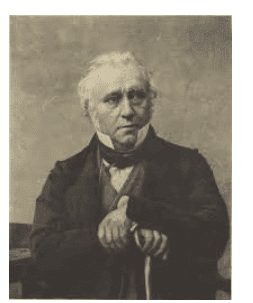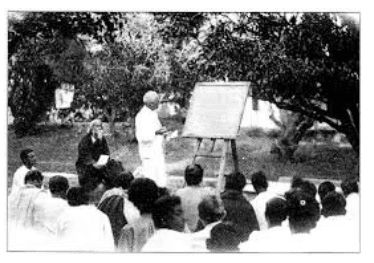Class 8 History Chapter 6 Question Answers - Our Pasts III (Part - II)
Very Short Answer Questions
Q1: Name the different languages that William Jones studied.
Ans: Greek, Latin, English, French, Arabic and Persian.
Q2: Why was Calcutta Madrasa set up?
Ans: Calcutta Madrasa was set up to promote the study of Arabic, Persian and Islamic law.
Q3: Why was the Hindu College established in Benaras?
Ans: The Hindu College was established in Benaras to encourage the study of ancient Sanskrit texts that would be useful for the. administration of the country.
Q4: Name two individuals who sharply attacked the Orientalists.
Ans: James Mill and Thomas Babington Macaulay.
Q5: What did Thomas Macaulay urge the British government in India?
Ans: Thomas Macaulay urged the British government in India to stop wasting public money in promoting Oriental learning for it was of no practical use. Thomas MacaulayQ6: How were Oriental institutions like the Calcutta Madrasa and Benaras Sanskrit College viewed by the British?
Thomas MacaulayQ6: How were Oriental institutions like the Calcutta Madrasa and Benaras Sanskrit College viewed by the British?
Ans: These Oriental institutions were viewed as temples of darkness that were falling of themselves into decay.
Q7: Name the places where the British established universities.
Ans: Calcutta, Madras and Bombay.
Q8: Where were classes held under the system of pathshalas?
Ans: Classes were held under a banyan tree or in the comer of a village shop or temple or at the guru’s home. Village PathshalasQ9: What type of education was given to the children in pathshalas?
Village PathshalasQ9: What type of education was given to the children in pathshalas?
Ans: Children were given oral education in pathshalas.
Q10: How did Tagore view his school namely Shantiniketan?
Ans: He viewed his school as an abode of peace where living in harmony with nature, children would cultivate their natural creativity.
Short Answer Type Questions
Q1: Why did many Company officials in India want to promote Indian rather than Western learning?
Ans: Many Company officials felt that institutions should be set up to encourage the study of ancient Indian texts and teach Sanskrit and Persian literature and poetry. These officials were of the opinion that Hindus and Muslims ought to be taught what they were already familiar with and what they valued and preserved, not subjects that were alien to them. They believed that only by doing this the British could win the hearts of the Indians, only then they could expect to be respected by their subjects.
Q2: What were the views of other Company officials?
Ans: Other Company officials did not approve the ideas of the Orientalists. They began to criticise the Orientalist- vision of learning. They saved that the knowledge of the East was full of errors and unscientific thought. They saw Eastern literature as non-serious and light-hearted. So, they argued that it was wrong on the part of the British to spend so much effort in encouraging the study of Arabic and Sanskrit language and literature.
Q3: Define the term ‘vernacular’. Why did the British use this term in colonial countries like India?
Ans: The term Vernacular’ refers to a local language or dialect as distinct from what is known as the standard language.
In colonial countries like India, the British used this term to mark the difference between the local languages of everyday use and English, the language of the imperial masters.
Q4: What measures were taken by the English Education Act of 1835?
Ans: The English Education Act of 1835 implemented several significant measures:
- English became the primary language of instruction for higher education.
- Support for Oriental institutions, such as the Calcutta Madrasa and Benaras Sanskrit College, was halted, as they were viewed as outdated.
- Production of English textbooks for schools was initiated.
Q5: What measures were taken by the British after issuing of Wood’s Despatch?
Ans: Following the issuance of Wood's Despatch in 1854, the British implemented several key measures:
- Education departments were established to oversee all aspects of education.
- A system of university education was introduced, with universities founded in Calcutta, Madras, and Bombay.
- Efforts were made to reform the school education system.
Q6: How were the views of Tagore and Mahatma Gandhi on the West different?
Ans: Both Tagore and Mahatma Gandhi thought about education in similar ways. But there were differences too. Gandhiji was highly critical of Western civilisation and its worship of machines and technology. Tagore wanted to combine elements of modem Western civilisation with what he saw as the best within Indian tradition. He emphasised the need to teach science and technology at Shantiniketan, alongwith art, music, and dance.
Long Answer Type Questions
Q1: What was Wood’s Despatch? What were its provisions?
Ans: The East India Company sent an educational despatch to the Governor-General in India in 1854, known as Wood's Despatch, named after Charles Wood, the President of the Board of Control.
This despatch outlined the educational policy for India, focusing on the following key points:
- Critique of Oriental Knowledge: It criticised traditional Eastern education, arguing that it was flawed and ineffective.
- Promotion of European Learning: The despatch advocated for European education, claiming it would help Indians understand the benefits of trade and commerce.
- Economic Development: European learning was seen as essential for developing India's resources and creating a demand for British goods.
- Moral Improvement: It suggested that European education would enhance the moral character of Indians, making them more honest and reliable.
- Need for Civil Servants: The despatch argued that educated Indians would provide trustworthy civil servants for the Company.
Q2: What measures were undertaken by the Company to improve the system of vernacular education?
Or
How were the irregularities of pathshalas checked by the Company?
Ans: The Company recognised the need to improve the system of vernacular education in India, particularly after 1854. To address the irregularities in pathshalas, several measures were implemented:
- The Company appointed government pandits to oversee groups of four to five schools, aiming to enhance teaching standards.
- Each guru was required to submit regular reports and adhere to a structured timetable for classes.
- Teaching was standardised to rely on textbooks, with learning assessed through annual examinations.
- Students were expected to pay a fee, attend classes regularly, sit in designated seats, and follow new disciplinary rules.
Pathshalas that complied with these regulations received government support, while those that resisted were denied assistance. This shift made it challenging for independent gurus to compete with government-funded institutions. Additionally, the new rules required consistent attendance, which affected children from poorer families, especially during harvest seasons.
Q3: What type of education did Mahatma Gandhi want in India?
Ans: Mahatma Gandhi opposed English education because it fostered a sense of inferiority among Indians. He believed it undermined their pride in their own culture and made them feel alien in their own land.
Key points of Gandhi's educational philosophy include:
- Education should restore dignity and self-respect among Indians.
- He encouraged students to leave schools to protest against British rule.
- Indian languages should be the medium of instruction, not English.
- Education should focus on practical skills and crafts, not just reading and writing.
- Gandhi argued that true education develops both the mind and the soul.
He felt that merely learning to read and write was insufficient. Instead, people should:
- Engage in hands-on work and learn a craft.
- Understand how different things operate to enhance their capacity to learn.
In summary, Gandhi envisioned an education system that was rooted in Indian culture and practical knowledge, aimed at empowering individuals and fostering a sense of community.
Q4: Write a note on Rabindranath Tagore and his school Shantiniketan.
Ans: Rabindranath Tagore, like Mahatma Gandhi, also did not approve Western education wholeheartedly. At the time when several Indians urged the British to open more and more schools, colleges and universities in order to spread English education in India, Rabindranath Tagore reacted strongly against such education.
He was a great educationist But he hated going to school because he saw it oppressive. In fact he wanted to establish a school where the children were happy and were free to explore their thoughts and desires without feeling any suppression. He advocated for giving children natural surroundings where they would be able to cultivate their natural creativity.
Keeping the above ideals in mind, Rabindranath Tagore established Shantiniketan in the year 1901. He regarded it as an ‘abode of peace’. He set up his school 100 kilometers away from Calcutta, in a rural setting in order to provide children a very peaceful environment. Here, they could develop their imagination and creativity. Tagore was of the opinion that existing schools were killing the natural desires of the children to be creative. Hence, it was necessary to help them develop their curiosity by providing them good teachers who could understand them.
By establishing an institution like Shantiniketan he did a great job in the field of education.
|
65 videos|424 docs|46 tests
|
FAQs on Class 8 History Chapter 6 Question Answers - Our Pasts III (Part - II)
| 1. What is the main argument presented in "Civilising the Native, Educating the Nation"? |  |
| 2. How did colonial education impact indigenous cultures? |  |
| 3. What role did missionaries play in the education of natives during the colonial period? |  |
| 4. In what ways did the colonial education system differ from traditional education systems? |  |
| 5. What are the lasting effects of colonial education on post-colonial nations? |  |



















